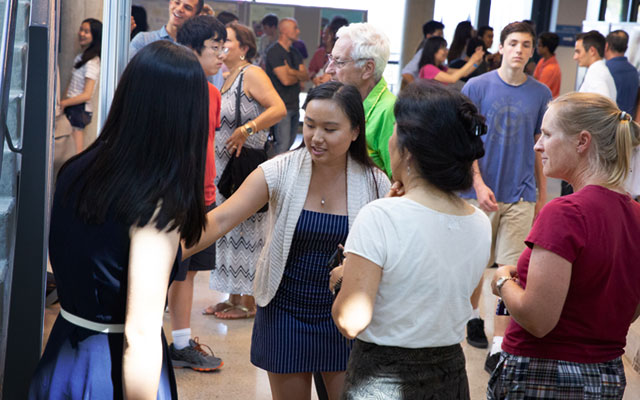

 Skip to navigation
Skip to navigation
Site Primary Navigation:
- About SDSC
- Services
- Support
- Research & Development
- Education & Training
- News & Events
Search The Site:

Published August 21, 2018

Participants present their projects at the poster session that concluded this year’s REHS summer internships at SDSC. Image: Jon Chi Lou, SDSC
With the 2018 Research Experience for High School Students (REHS) summer internships now over, data collected and analyzed as one of several projects of this year’s program shows that many previous REHS participants followed a computer science and engineering (CSE) path into college, graduate school, and beyond.
The study, conducted by students Mihir Gupta from Scripps High School and Andrew Liu from Del Norte High School in the San Diego area is based on responses from 154 students who participated in any of the previous eight years of the REHS summer programs (2010-2017). The study is based on student and mentor data, coupled with alumni responses to a questionnaire survey. Participants came from 59 high schools from all over greater San Diego, and in some cases even outside the area.
Held at the San Diego Supercomputer Center (SDSC), REHS is a hub for students who may be interested in having firsthand experience as they consider pursuing a career in this area.
The survey found that 70% of REHS alumni who attended college attended a top 20 global university for their undergraduate education as ranked by U.S. News & World Report. Just this month, Money Magazine listed UC San Diego in the No. 2 spot in its new 2018 Best Colleges for Your Money ranking.
Other REHS survey highlights:
“I am very proud of what this data suggests,” said Ange Mason, SDSC’s education manager and founder of the REHS program. “While we realize that students who apply for this internship may be predisposed to computer science engineering or a related field, it’s gratifying to see how many of them pursue CSE in their university years and into their early careers.”
REHS students Gupta and Liu used SuAVE (Survey Analysis via Visual Exploration), an online tool for exploratory survey data analysis developed by SDSC Researcher Ilya Zaslavsky. SuAVE is used for teaching research methods to undergraduate students and helps visualize data using techniques from image analytics, faceted search, and online map navigation. Also used was pandas, an open source, BSD-licensed library providing high-performance, easy-to-use data structures and data analysis tools for the Python programming language.
“We also learned many things outside of our project,” said Gupta and Liu as they presented their findings at a poster session on August 10. “We got the chance to interview many researchers and ask them about their careers and jobs. Overall, REHS gave us real-life experience in the workplace as well as research experience and mentorship, all of which we consider as invaluable tools that will definitely help us in our educational and vocational futures.”
Applications for SDSC’s REHS program are available on an annual basis on February 15. A program overview and other details can be viewed here.
About SDSC
As an Organized Research Unit of UC San Diego, SDSC is considered a leader in data-intensive computing and cyberinfrastructure, providing resources, services, and expertise to the national research community, including industry and academia. Cyberinfrastructure refers to an accessible, integrated network of computer-based resources and expertise, focused on accelerating scientific inquiry and discovery. SDSC supports hundreds of multidisciplinary programs spanning a wide variety of domains, from earth sciences and biology to astrophysics, bioinformatics, and health IT. SDSC’s petascale Comet supercomputer is a key resource within the National Science Foundation’s XSEDE (Extreme Science and Engineering Discovery Environment) program.
Share